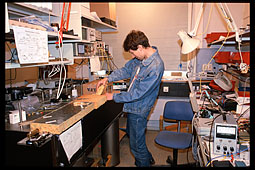

- I needed to keep exposure time reasonably short (a standing man can't hold completely still for long time, even if told so)
- and keep the aperture wide enough, so that the flash with limited power could illuminate the scene.
You have to understand first what DOF is. There are many explanations on the Web and no one is perfect. Well, you may try What is DOF? or Lens Tutorial.
I found that using auto DOF mode is way more reliable than trying to guess what single point you need to focus at and what aperture to choose in order to cover what you need with DOF. Such guess fails more often than not.
On most Canon bodies (including my
On low-end Canon bodies with multiple focusing points like my
In technical info for my photographs, I write down
Sometimes I want to (or can) get only a range of objects within DOF:
As you may see from the examples, usually there is not much extra DOF and room for errors. Setting exactly proper aperture and focusing the lens precisely helps to get the best picture possible. I use auto DOF mode a lot.
This mode is only available on Canon bodies
(but not on Nikon, Minolta, Pentax, etc.).
That pretty much decides the brand war to me.
I'm glad I got into the Canon system
While auto DOF mode is pretty reliable (with the above precautions and some care), it's no substitute for learning DOF. In particular, having a pocket DOF chart in my camera bag helped me to get a feel of it and estimate DOF in different situations. With lenses that have focusing scale, the chart can be sometimes used to set focus and aperture manually.
I thought your DOF page was quite over simplified. You mentioned a certain "feature" that Canon has which the other companies are "lacking in." However, I have a DOF button on my Nikon F2s which shows me immediately what will or will not be in focus. It merely stops down the lens. Plus all my Nikon Manual lenses have very nice Depth of Field scales on them. Additionally, the Anti-vibration mirror return is un-equaled in the camera world. I can routinely take 1/4 second and 1/8 second photos without experiencing any blur or vibration. And I have several excellent photos taken at 1 second.I use the depth of field button all the time when I photograph, and enjoy your explaination of why it is so important.
This "focus on one thing, calibrate, focus on another, and add second calibration" seems too complex and timely, and quite uneeded. I'm glad none of my Nikons have this clumsy feature.
-- Mark Gholson (mark_gholson@yahoo.com), April 14, 2003
Mark Gholson has completely missed the point of this article. While practically every camera manufactured since the mid-sixties has a depth-of-field preview button (which just stops the lens down), only Canon has automated the DOF setting such that the photograper defines his own DOF and the camera adjusts the aperture to match. While I am sure his Nikon DOF preview button works quite well (as did the one on my 1968 Practika) it is still largely a matter of guesswork with regard to the distance the subjects are away from the camera and setting the aperture manually. Using the auto focus and DOF facility takes away the guesswork and allows creativity through the viewfinder rather than continually checking the old manual DOF scales on the lens.
-- Alan Newbury (alannew@optusnet.com.au), November 13, 2004
I’m surprised to see that Alan Newbury “completely missed” my point as well.My desired Depth of Field changes with every photo I take. And with the Depth of Field button, I can see exactly what is in focus and what is not.
It only takes me one second to adjust the aperture for the desired DOF. With my F2 and F3 I get 100% of the image in the viewfinder and can make very quick adjustments.
The zone-focus scales on my Non-AI lenses are very quick and accurate. Perhaps Alan doesn’t have any experience with these lenses.
I’ve used Zone-Focus on quite a lot of other cameras with equally good results: Rollei 35T and TLR, Super Graphic, Deardorf 8x10, Kodak IIIc, Busch Pressman.
The DOF button seems to be missing on the newer autofocus cameras. Nikon F3 is my newest film camera, so I wouldn’t know.
I photograph very differently with digital cameras, and this hasn’t been an problem.
I think the Canon Rebel is a nice camera. However this feature is something I would never use.
— Mark Gholson (mark_gholson@yahoo.com), February 16, 2006
I am not a professional, but an amateur who likes photography as a hobby. I have a Canon Rebel 35 mm and Digital with 3 lenses. The first is an 18–35 mm, the second is a 20–35 mm wide angle, and the third is a 75–300 mm zoom lens. I have played around with both cameras (I use the digital to determine the settings that I think are best, then set the film camera to those settings and take a photo when I want film quality results).I am trying to understand all the different features and have become overwhelmed by all the manual flexibility of the cameras.
So after a lot of trial and error, I decided to use the A/F feature with
A-DEP and have had overall a tremendous amount of luck. I do have to use Photoshop to finish the pictures on the digital, but it is well worthwhile as I have gotten (or at least I think so). I have been able to stitch them together with a remarkable amount of success, I can crop them and many other things with them.As an amateur, I am a firm believer in the KISS (keep it simple stupid) principle and the article was informative to me and I appreciate your efforts. Other brand cameras can achieve the same results, it’s just a matter of how you accomplish it.
— Floyd French (ffrench2@kc.rr.com), March 27, 2008